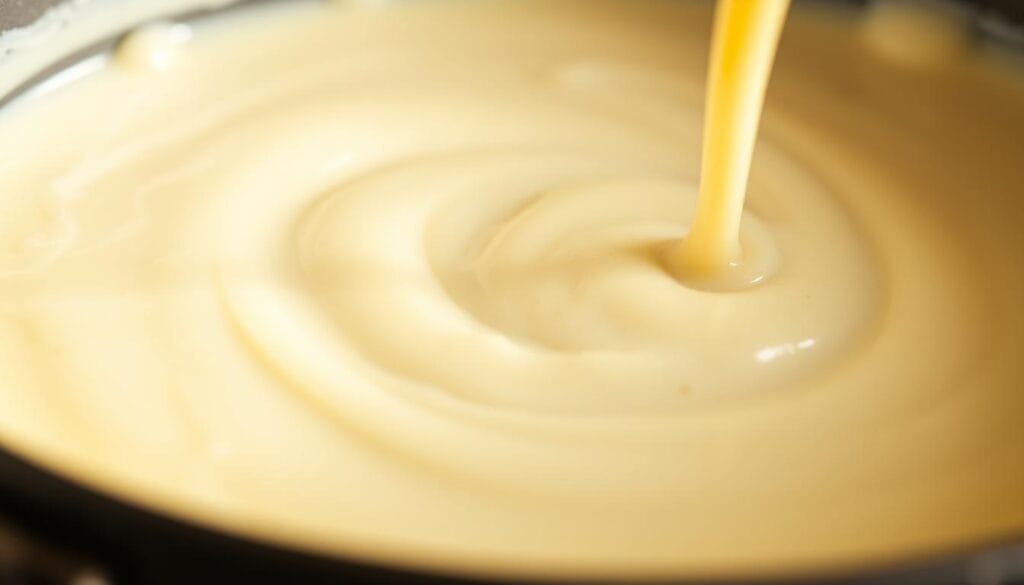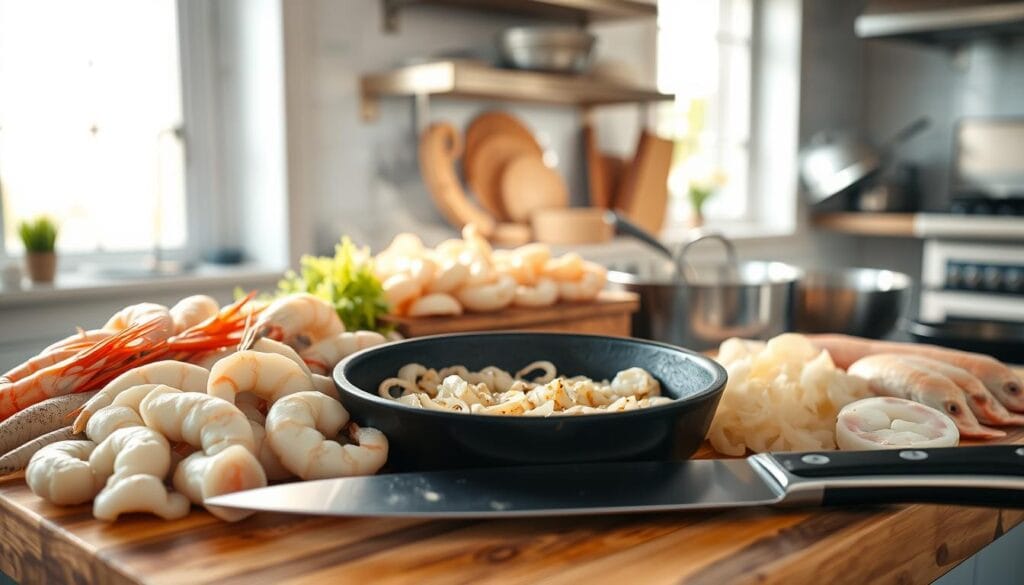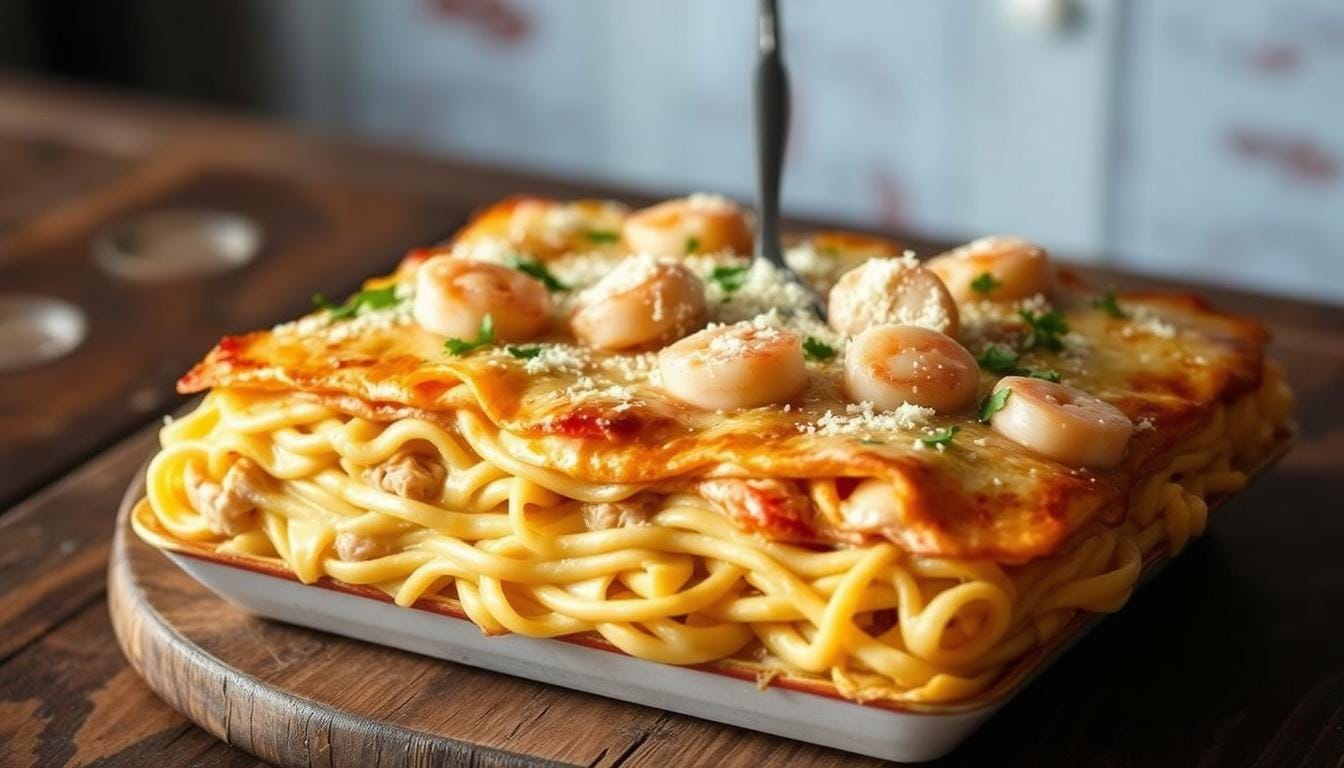There’s something magical about preparing a meal that brings people together. Imagine the aroma of a creamy white sauce mingling with layers of tender seafood and rich cheeses like Parmesan filling your kitchen. This dish isn’t just food—it’s an experience, a way to create memories with every bite.
Perfect for entertaining or a cozy family dinner, this recipe is designed to simplify your cooking process. With its make-ahead convenience, you can focus on enjoying the moment rather than stressing over last-minute preparations. Each layer of lasagna noodle is carefully balanced with flavors and textures, ensuring every forkful is a delight.
Whether you’re a seasoned cook or trying something new, this step-by-step guide will walk you through the process with ease. Let’s dive into creating a dish that’s as impressive as it is delicious.
Table of Contents
An Introduction to Seafood Lasagna recipe
This dish has evolved into a favorite for both special occasions and everyday meals. Its origins trace back to Italian cuisine, where traditional meat-based versions were reimagined with a rich mix of seafood and a velvety white sauce. Over time, it has gained popularity as a sophisticated yet approachable dish.
What sets this dish apart is the balance between the creaminess of the sauce and the delicate flavors of various seafood. Each layer of noodle is carefully paired with a blend of cheeses like Parmesan and mozzarella, creating a harmonious mix of textures and tastes. The preparation time, though requiring a few extra minutes, is well worth the effort for the final result.
To make this dish, you’ll need quality noodles and curated sauces. Essential equipment includes a baking pan and a sturdy whisk for the sauce. The versatility of this dish makes it perfect for upscale holiday meals or convenient weeknight dinners. Its sophistication is echoed in numerous online reviews, highlighting its ability to impress both family and guests.
Here’s a quick overview of the key components:
| Ingredient | Quantity |
|---|---|
| Lasagna Noodles | 12 sheets |
| Shrimp | 1 lb |
| Scallops | 1 lb |
| Crab Meat | 1 cup |
| Ricotta Cheese | 3 cups |
| Parmesan Cheese | 1/2 cup |
| Mozzarella Cheese | 3 cups |
With its rich flavors and elegant presentation, this dish is sure to become a staple in your kitchen. Whether you’re hosting a gathering or enjoying a quiet evening, it’s a meal that brings people together.
Seafood Lasagna Recipe: Essential Ingredients
The key to any great dish is its ingredients. For this recipe, fresh and high-quality components are key to achieving impeccable taste and texture. Each element plays a vital role in creating a harmonious blend of flavors.
Start with the basics: unsalted butter, all-purpose flour, and whole milk for the creamy sauce. These form the base that ties everything together. For the seafood mix, use a combination of shrimp, scallops, and crab meat. Freshness is crucial here to ensure the best flavor.
Cheese is another star of this dish. A blend of ricotta, Parmesan, and mozzarella adds richness and depth. Seasonings like salt, pepper, and a hint of nutmeg enhance the flavors without overpowering the seafood.
Here’s a detailed list of the essential ingredients and their quantities:
| Ingredient | Quantity |
|---|---|
| Lasagna Noodles | 12 sheets |
| Shrimp | 1 lb |
| Scallops | 1 lb |
| Crab Meat | 1 cup |
| Ricotta Cheese | 3 cups |
| Parmesan Cheese | 1/2 cup |
| Mozzarella Cheese | 3 cups |
| Unsalted Butter | 3 tbsp |
| All-Purpose Flour | 3 tbsp |
| Whole Milk | 2.5 cups |
| Salt | 1 tsp |
| Pepper | 1 tsp |
For those with dietary restrictions, substitutions like gluten-free noodles or alternative cheeses can be used. Balancing salt and pepper is essential to bring out the natural flavors of the seafood and sauce. With these ingredients, you’re set to create a dish that’s both delicious and versatile.
Preparing Your Seafood and Pasta
Crafting a memorable meal starts with selecting the finest ingredients. The quality of your components directly impacts the final flavor and texture of your creation. Let’s dive into the essentials of preparing your seafood and pasta for the perfect dish.
Selecting the Freshest Seafood
When choosing shrimp, look for firm, translucent flesh with a mild ocean scent. Avoid any with a slimy texture or strong odor. For crab, opt for fresh or high-quality canned options, ensuring it’s free from any off-putting smells.
Handling seafood properly is crucial. Rinse shrimp under cold water and pat them dry before cooking. For crab, remove any shells or cartilage to preserve its delicate texture. A well-balanced mixture of seafood ensures every bite is harmonious and flavorful.
Perfecting Your Lasagna Noodles
Start by boiling your noodles in salted water until they’re al dente. This ensures they hold their shape during layering. Avoid overcooking, as mushy noodles can ruin the texture of your dish.
Once drained, rinse the noodles with cold water to halt the cooking process. Lightly oil them to prevent sticking. Timing is key—prepare your seafood and noodles simultaneously to ensure cohesive flavor integration.
With these tips, you’ll create a meal that’s as impressive as it is delicious. Fresh ingredients and careful preparation are the foundation of a standout dish.
Crafting the Creamy White Sauce

Mastering the art of a creamy white sauce can elevate any dish to gourmet status. This section will guide you through the steps to create a smooth, velvety béchamel sauce that’s the foundation of many classic meals. With a few simple techniques, you’ll achieve a sauce that’s rich, flavorful, and perfectly balanced.
Béchamel Sauce Techniques
Start by melting 3 tablespoons of unsalted butter in a medium saucepan over low heat. Once melted, add 3 tablespoons of all-purpose flour and whisk continuously to create a roux. This step is crucial for toasting the flour, which removes its raw taste and ensures a smooth texture.
Next, slowly pour in 2.5 cups of whole milk, whisking constantly to prevent lumps. Maintain a low heat to prevent the milk from burning. As the sauce thickens, it will develop a creamy consistency. This process typically takes about 5-7 minutes.
Adjusting Seasonings for Rich Flavor
Once your sauce has thickened, it’s time to season it. Add 1 teaspoon of salt and 1 teaspoon of black pepper for a balanced flavor. For a hint of warmth, consider a pinch of nutmeg. Taste along the way, adjusting the seasonings to match your preference.
If the sauce becomes too thick, you can thin it with a bit of leftover milk or broth. On the other hand, if it’s too thin, let it simmer a bit longer to reduce. Consistency is key, so aim for a sauce that coats the back of a spoon.
“A well-made béchamel is the backbone of countless dishes. Take your time, and don’t rush the process—it’s worth it.”
Here’s a quick reference table for the nutritional details of the sauce:
| Nutrient | Amount per Serving |
|---|---|
| Calories | 120 kcal |
| Total Fat | 8 g |
| Saturated Fat | 5 g |
| Carbohydrates | 9 g |
| Protein | 4 g |
| Sodium | 300 mg |
With these tips, you’ll create a white sauce that’s both versatile and delicious. Whether you’re using it as a base or a finishing touch, it’s sure to impress.
Layering Techniques and Assembly Tips
Layering is the secret to a visually stunning and flavorful dish. Each element should be thoughtfully arranged to guarantee a balanced bite. Start by organizing your ingredients in separate bowls. This will streamline the process and keep everything within reach.
Creating Even Layers
Start by spreading a thin layer of sauce at the bottom of your baking dish. This prevents the noodles from sticking. Next, add a layer of noodles, followed by the ricotta mixture. Spread it out evenly to cover the whole surface.
Add your seafood mixture, ensuring it’s distributed uniformly. Sprinkle a generous amount of parmesan and mozzarella for richness. Repeat these steps, finishing with a layer of sauce and cheese on top. This guarantees that each bite is full of flavor.
Managing Your Assembly Process
Keep your workspace organized to avoid mixing ingredients. Use a spoon or spatula to gently press each layer. This preserves the texture and integrity of the dish. Avoid overloading any single layer, as it can make the dish uneven.
For a professional touch, garnish with fresh parsley before baking. This brings a burst of color and freshness. Once assembled, let the dish rest for 10-15 minutes before baking. This allows the flavors to meld together.
- Organize ingredients in separate bowls for easy access.
- Spread each layer evenly to ensure balanced flavors.
- Gently press layers to maintain texture.
- Finish with a layer of sauce and cheese for a golden top.
- Garnish with parsley for a fresh, vibrant look.
With these tips, you’ll create a dish that’s as beautiful as it is delicious. Ideal for any event, it’s guaranteed to wow your guests.
Step-by-Step Cooking Process

Creating a masterpiece in the kitchen starts with precision and patience. This section will guide you through the cooking process, ensuring every step is executed perfectly for a dish that’s both flavorful and visually stunning.
Cooking Seafood to Perfection
Begin by heating a large pan on medium heat. Add a drizzle of oil and cook the seafood until it turns pink and tender, about 5-7 minutes. Avoid overcooking to keep it moist and flavorful. A helpful tip: remove the seafood from the heat just before it’s fully done, as it will continue to cook in the oven.
Once cooked, set the seafood aside and prepare the white sauce. IIn the same pan, melt butter and stir in flour to form a roux. Slowly pour in the milk, stirring continuously until the sauce thickens. Stir in salt, pepper, and a pinch of nutmeg to boost the flavor.
Baking and Finishing Touches
Preheat your oven to 375°F. Assemble the dish by layering noodles, ricotta cheese, seafood, and white sauce. Repeat the layers, finishing with a generous sprinkle of mozzarella cheese on top. This ensures a golden, bubbly crust.
Bake uncovered for 40-50 minutes, or until the top is golden and the sauce is bubbling. If you’ve assembled the dish ahead of time, increase the baking time by 10-15 minutes. A final tip: let the dish rest for 10 minutes before slicing. This helps the layers firm up, making it easier to serve.
For a finishing touch, garnish with fresh parsley and an extra sprinkle of mozzarella. This not only enhances the flavor but also adds a vibrant pop of color to your creation.
Make-Ahead Strategies and Storage Tips
Planning ahead can transform your cooking experience, making it stress-free and efficient. By preparing key components in advance, you can save time and ensure your dish retains its flavor and texture. Here’s how to master make-ahead techniques and storage for a seamless cooking process.
Preparing Ingredients in Advance
Start by making the white sauce and ricotta filling a day or two before. Keep them in airtight containers and refrigerate. This allows the flavors to meld and simplifies the final assembly. For the seafood, cook it lightly and set aside in a separate container. Avoid overcooking, as it will finish in the oven.
When it comes to pasta, boil the noodles until they’re al dente. Rinse them under cold water, lightly oil, and store in a sealed container. This prevents sticking and ensures they’re ready for layering. Pre-cooked ingredients can be safely stored for up to 2 days, maintaining their quality.
Storing and Reheating Tips
If you’ve assembled the dish ahead of time, cover it tightly with foil and refrigerate. Before baking, allow it to sit at room temperature for 15-20 minutes. This helps the layers heat evenly. If baking straight from the refrigerator, add an extra 10-15 minutes to the cooking time.
For reheating leftovers, use the oven at 350°F (175°C) for 20-30 minutes, covered with foil to prevent drying out. Alternatively, heat individual portions in the microwave on high for 2-3 minutes. A sprinkle of black pepper before serving can enhance the flavor.
- Prepare sauces and fillings in advance for easier assembly.
- Store seafood and pasta separately to maintain texture.
- Refrigerate assembled dishes for up to 2 days before baking.
- Adjust baking time if cooking straight from the refrigerator.
- Reheat leftovers gently to preserve flavor and moisture.
With these strategies, you can make seafood lasagna effortlessly, even on busy days. Proper storage and reheating ensure every bite is as delicious as the first.
Conclusion
Bringing together layers of flavor and texture, this dish is a testament to thoughtful preparation. From the delicate scallop to the rich homemade sauce, each component plays a vital role. The careful layering process ensures every bite is balanced and satisfying.
Don’t hesitate to experiment with ingredients while keeping the core techniques intact. Whether you use foil for baking or adjust the butter in the sauce, small tweaks can make a big difference. Always stir your sauce gently to maintain its smooth consistency.
After baking, let the dish rest for 10-15 minutes. This helps the flavors blend and makes slicing simpler. Serve it warm, and enjoy the taste of a meal made with care. Whether it’s a family dinner or a gathering with friends, this dish is sure to create lasting memories.
FAQ
Can I use frozen seafood for this dish?
Yes, you can use frozen seafood if fresh isn’t available. Just ensure it’s thoroughly thawed and patted dry before cooking to avoid excess moisture.
What’s the most effective way to stop lasagna noodles from sticking together?
After boiling, rinse the noodles under cold water and lay them flat on a clean kitchen towel. Lightly drizzle olive oil to prevent sticking.
Is it possible to replace ricotta cheese with a different type of cheese?
Yes, cottage cheese or a blend of cream cheese and mascarpone can work as substitutes for ricotta, though the texture and flavor may vary slightly.
How do I know when the dish is fully baked?
The top should be golden brown, and the edges should bubble slightly. Insert a knife into the center; it should come out hot to the touch.
Can I prepare this dish ahead of time?
Absolutely. Assemble the layers, cover with foil, and refrigerate for up to 24 hours. Bake straight from the fridge, allowing a few additional minutes for the cooking time.
What’s the best way to store leftovers?
Store leftovers in an airtight container in the fridge for up to 3 days. Reheat in the oven or microwave until heated all the way through.
Can I add other types of seafood to the recipe?
Yes, scallops, clams, or even lobster can be added for variety. Just ensure they’re cooked properly before layering.
How can I make the white sauce thicker?
Simmer the sauce longer to reduce it, or add a small amount of cornstarch slurry (cornstarch mixed with water) while stirring constantly.
What’s the best method to reheat this dish without it becoming dry?
Cover it with foil and reheat in the oven at 350°F for about 15-20 minutes. Adding a splash of milk or cream can help retain moisture.
Can I freeze this dish for later use?
Yes, you can freeze it before baking. Secure it tightly with foil and plastic wrap. Defrost in the refrigerator overnight before baking according to the instructions.

